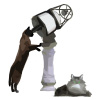
The Astrophysics Spectator
Last week in the books store I scanned the shelves for new and interesting books
in physics and astronomy. What book stood out?
Earlier in the month, in the run-up to the latest episode of Star Wars,
one of the cable channels aired a program called The Science of Star Wars,
and years earlier, I saw a book by a cosmologist called
.
I suppose most would look at this list and scratch their heads only about the Harry
Potter book, but I actually see no difference among these books, because in truth
neither Star Wars nor Star Trek contain science; they are fantasies,
and attempts to push them into a scientific box makes no more sense than pushing
The Tales of Narnia or The Hobbit into a scientific box.
In Star Wars, the term parsec, the basic measure of distance in astronomy,
is used as as a unit of time. Star Trek is not much more scientifically
sophistication, despite employing the buzz words from the more fantastically-speculative
frontiers of science. Science fiction has little to do with science. The tales of
travel between the stars , of voyages through time, of life in virtual reality, and
of humans battling intelligent machines are fantasies. The tales invoke a reality
that contradicts physics.
But the desire to put a scientific patina on theses fantasies is strong. While much of this is simply an attempt to profit from the success of these series, other motives are also at work. Star Trek does use the jargon of science, so why not use it as a launching pad to explain science to a new audience?
This is certainly the tact that the author of The Science of Harry Potter
takes. Roger Highfield, a science editor with the Daily Telegraph
of London, England, had previously written a book called
.
In his new book, he uses events within the Harry Potter books as starting points for
scientific discussions, such as how the magic of Harry Potter could be realized through
scientific principles, or what science tells us of the actions of Harry and his
acquaintances. So the magic of teleportation is the starting point for a discussion
of worm holes and quantum mechanics, and the student society of Hogwarts school is
the starting point for discussing game theory.
In some instances, links between fiction and science are created to add intellectual weight to a series. I suspect this is the reason behind George Lucas, the creator of the series, appearing in The Science of Star Wars and discussing current research on robots. It has long been claimed that science fiction foretells scientific advances. Although there are certainly authors who show foresight in their writings—Arthur C. Clarke comes to mind— I don't believe this claim generally true. But the claim persists in popular culture, giving to science fiction an intellectual respectability that lifts it above pure escapist literature.
A peculiar trait shared by the authors linking fantasy fiction to science is the insistence on linking to the wilder speculations within science. The usual suspects inhabiting the hidden lands of astronomy appear in these books: worm holes, cosmic strings, multidimensional universes, and alternate universes. The fantasy literature does not touch on science so much as on scientific fictions. Worm holes and cosmic strings have the air of the fantastic about them. These are objects unmotivated by observation, and unnecessary in our system of physics. I think of this physics as aesthetic physics, because it is driven by a desire to force physics into an aesthetically-pleasing form.
This scientific fiction, this creation of speculative theories, is motivated by a sense of order. Often this order is mathematical. This can be as simple as the assertion of many cosmologist that, despite evidence to the contrary, the universe is at the closure density, the boundary between an open and closed universe. In can also be quite complex, descending from a desire to link all physics to a single grand concept, such as grand unification in particle physics, which attempts to consolidate the different forces—gravity, electromagnetic, strong, and weak—into a single equation.
I've taken to calling this type of science aesthetic science, because it is science driven not by observational necessity, but by a subjective judgement of what makes the theories of physics more pleasing. Scientists who labor on these theories are laboring outside our observational bounds, and they populate these hidden lands with the children of their aesthetic theories. While fantastic, these objects are fundamentally from a world of understanding. It is the type of science that the earliest thinkers engaged in. It is not only the science of a universe at the closure density and of grand unification, but also the science of epicycles in an Earth centered theory of the Solar System.
We are drawn to the fantasy literature through our delight with surprise and wonderment. This desire to see the fantastic naturally invites us to populate the hidden lands of our universe with equally delightful wonders. W are drawn to the fantastic creatures of aesthetic science for reasons quite different from those motivating scientists to create them. Like the ancient map makers, who filled the empty spaces of their maps with drawings of giants, strange beasts, and sea monsters, our modern story tellers fill our universe with legendary objects drawn from the most speculative theories of science.
Freddie Wilkinson
